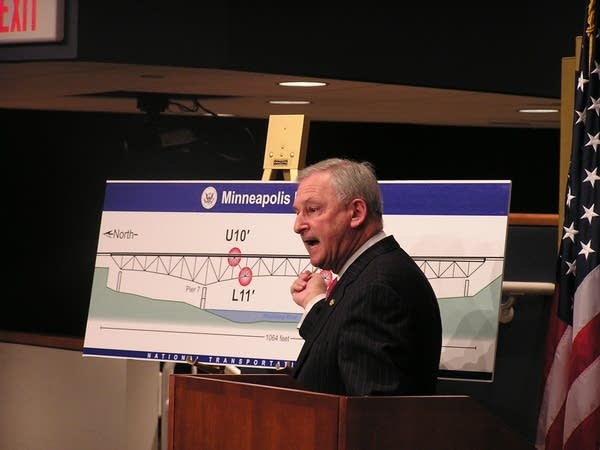Why did no one ever look at the gusset plates?
Go Deeper.
Create an account or log in to save stories.
Like this?
Thanks for liking this story! We have added it to a list of your favorite stories.

Throughout countless inspections, reviews and even when extra weight was added to the I-35W bridge, no one ever looked at the design of the gusset plates. Inspectors expressed concern about the strength of the bridge beams and corrosion and cracks on the bridge.
State bridge engineer Dan Dorgan said MnDOT never looked at the gusset plates because experts thought they were the strongest part of the bridge.
"The assumption made is that gussets will not be the weakest point in the design and in fact, computer programs that generally model these bridges do not have the capability to take gusset plates into consideration," he said. "They mainly look at the main members."
Gusset plates are designed to hold together each joint or node on the bridge. The triangular plates now appear to be the reason why the I-35W bridge collapsed. Thirteen people died and more than 100 people were injured.
Turn Up Your Support
MPR News helps you turn down the noise and build shared understanding. Turn up your support for this public resource and keep trusted journalism accessible to all.
The NTSB says the original designers of the bridge used gusset plates that were a half inch thick when they should have been an inch thick. What is most troubling, Dorgan said, is that the problem could have been picked up if they had looked for it.
"Had we done a gusset plate review, as we are undertaking at this moment, yes, that would have been discovered," he said
More weight was added to the bridge in 1977 and again in 1998. NTSB Chair Mark Rosenker said engineers never focused on the gusset plates when the center median barrier, the outside walls and extra concrete deck were added. Instead, he said the focus was on the approaches on the north and south sides of the bridge and the portion of the bridge that's closest to downtown, which was thought to be the weakest part.
"They were never anticipating that gusset plates could be the weak point in the bridge," he said.

Rosenker said bridge engineers typically look only at the weakest portions of a bridge when upgrades are made.
Roberto Ballarini, chair of the Civil Engineering Department at the University of Minnesota, agreed. He said the theory is that if the weakest parts of the bridge can handle extra weight, the entire bridge can handle it.
"Ideally, you want to do everything, but in this particular situation it is assumed that the gusset plate connections are stronger than the beams that run into the connection," he said. "So if calculations were done I would think that they probably just checked what is the effect of the additional load of the beams but they probably assumed that the gusset plates would not be the weak spot."
But those calculations will now have to be done. Transportation Secretary Mary Peters has ordered states to recheck the strength of gusset plates whenever extra weight will be added to a bridge.




